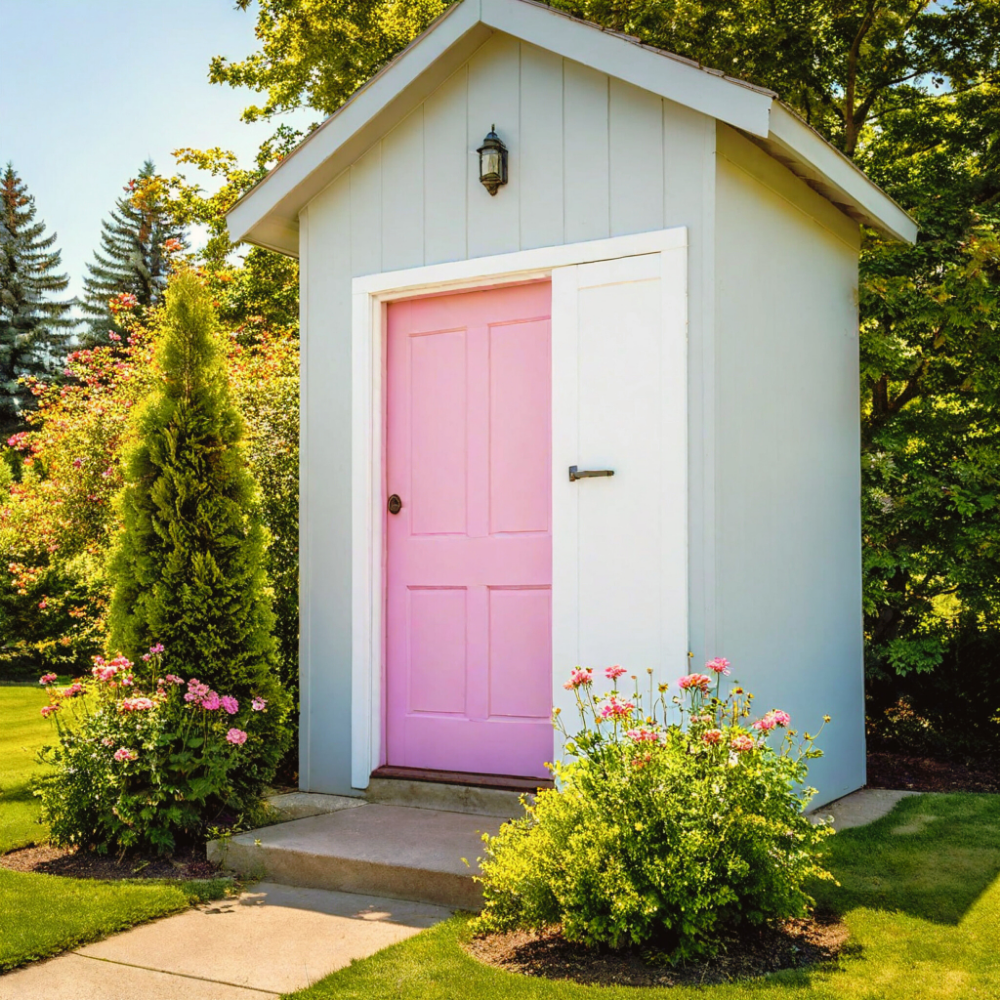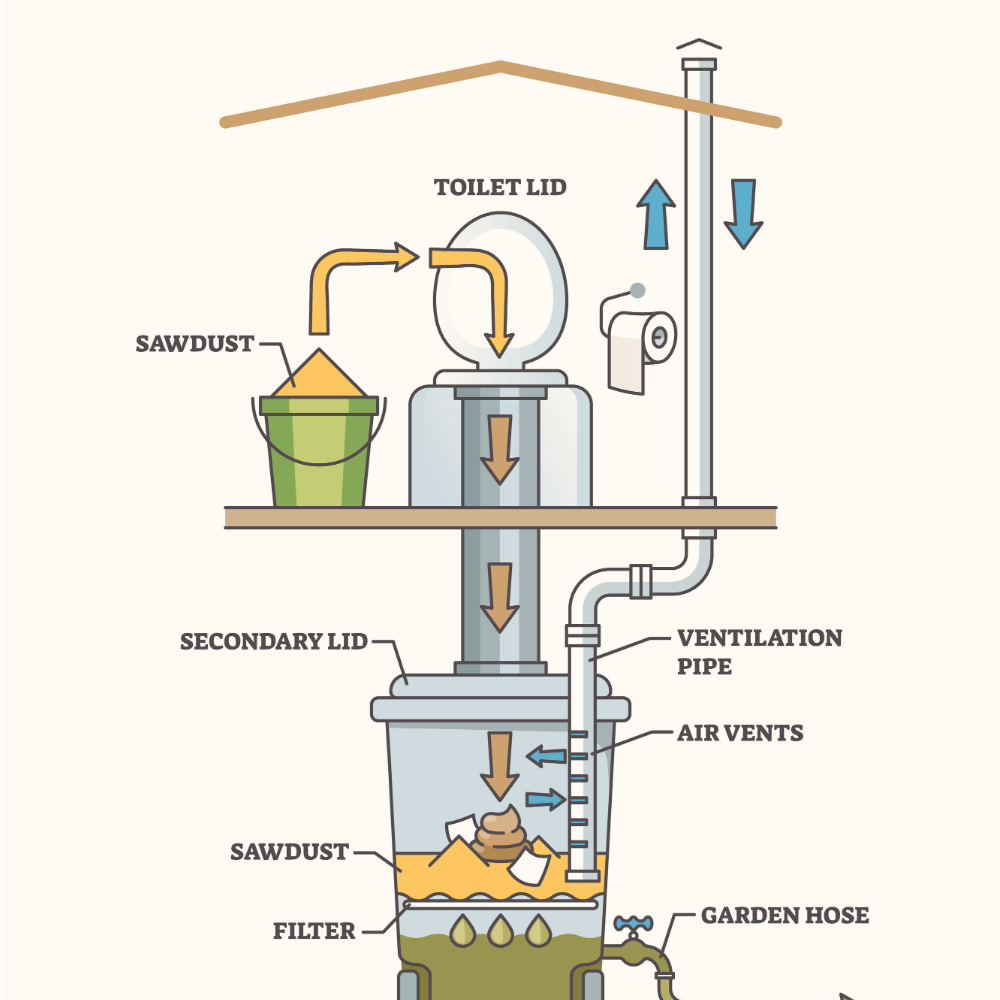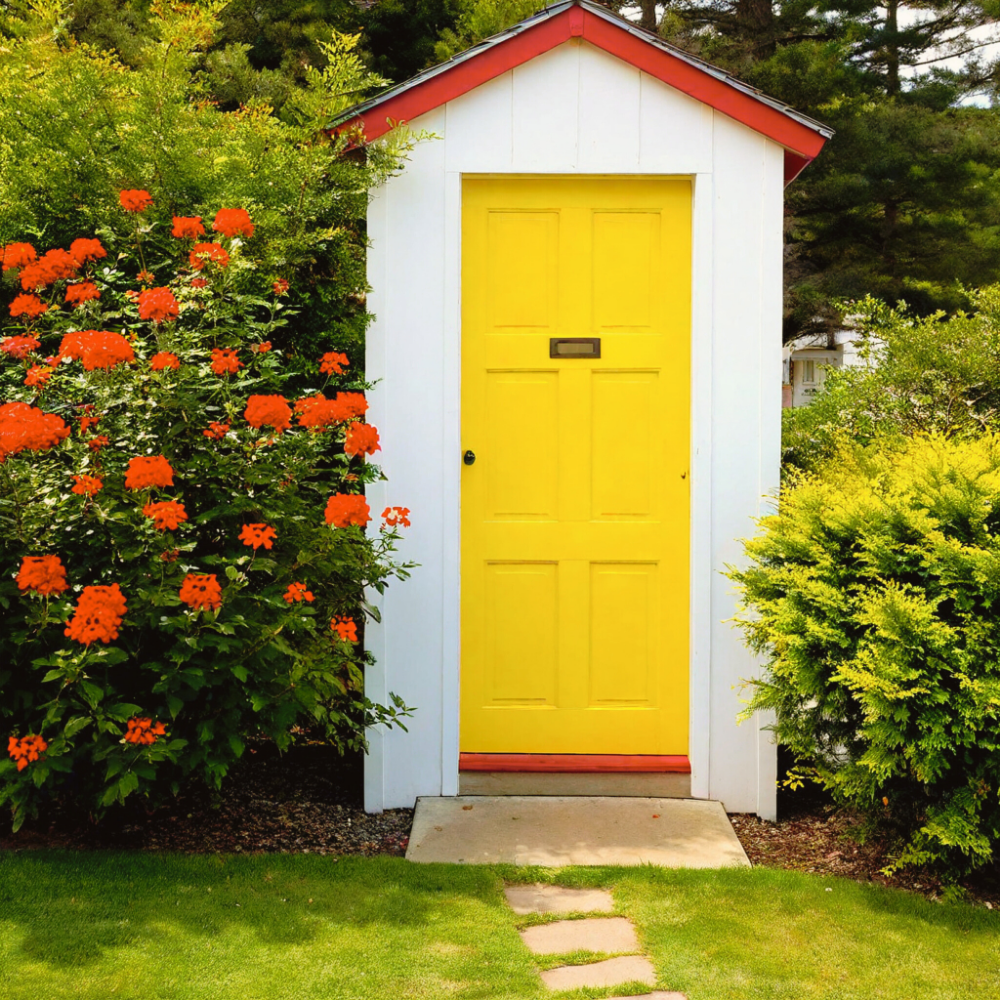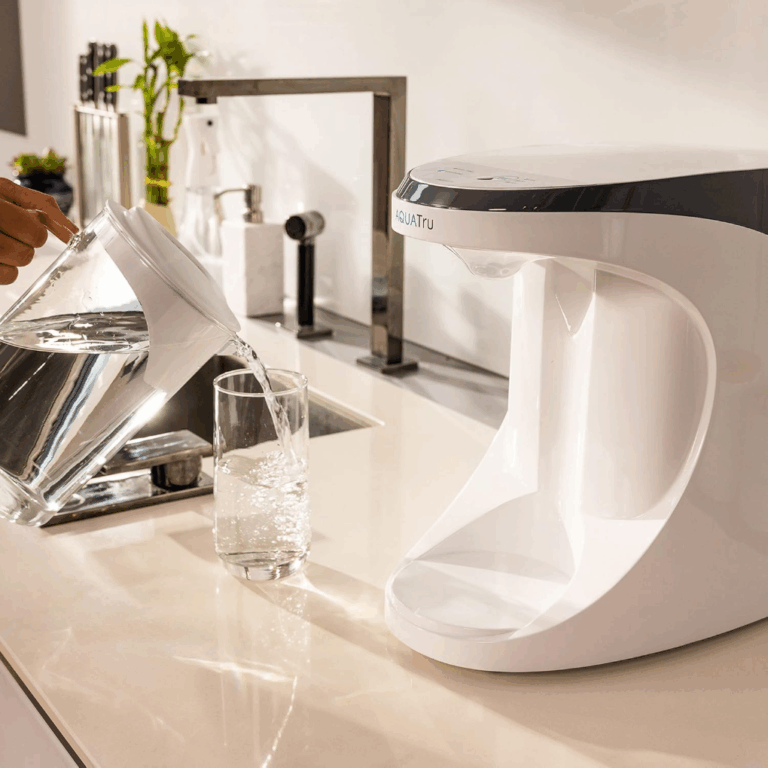
Key Takeaways
- A composting toilet works by separating waste, using aerobic microbes, and turning it into safe compost over time.
- These systems save thousands of gallons of water annually since they operate without flushing.
- Proper ventilation, moisture balance, and bulking agents like sawdust keep the process odor-free and efficient.
We rarely stop to think about it, but every flush sends precious drinking water down the drain. In fact, the average household toilet uses approximately 1.6 gallons each time, resulting in thousands of gallons wasted every year. That’s a lot of clean water for something we don’t even see again.
But what if there were a way to handle waste without flushing it away? That’s where composting toilets come in. Instead of relying on water and energy-intensive treatment plants, they use natural decomposition to recycle waste into safe, usable compost.
So, how does a composting toilet work? The answer is surprisingly simple, and it could change the way you think about bathrooms forever.
How Does a Composting Toilet Work?
A composting toilet is a dry toilet system that manages waste without the use of water. Instead of flushing waste into pipes and treatment plants, it relies on natural decomposition. Inside the unit, solids and liquids are often separated, and beneficial microbes break down the waste in an oxygen-rich environment. Over time, this process turns human waste into safe, usable compost for non-edible landscaping.
This is very different from conventional toilets, which use gallons of clean water per flush and depend on energy-intensive sewage treatment. A composting toilet skips that infrastructure entirely, recycling waste on-site with little more than airflow, moisture balance, and a carbon-rich material like sawdust or coconut coir.
There are several types of composting toilets to suit different spaces:
- Self-contained systems keep the composting chamber inside the bathroom itself.
- Remote or split systems separate the composting unit from the toilet fixture.
- Centralized systems collect waste from multiple toilets and store it in a single, larger composting chamber.
Regardless of the type, all composting toilets share a common purpose: converting what would otherwise be waste into a valuable resource while conserving water.
How Does a Composting Toilet Work?

The process behind a composting toilet is akin to nature’s magic, eliminating the need for fancy plumbing or water-guzzling systems. Instead of sending waste off to a treatment plant, a composting toilet works to break down and recycle waste right at home. Let’s break down the process step by step to see how it works:
Waste Collection and Separation
It all starts when you use the toilet. However, instead of everything mixing like in a conventional toilet, composting toilets often have a system that separates solids from liquids. In many self-contained units, the solid waste is collected in a compartment, while the liquids, mainly urine, are either stored separately or diverted to another system for easier processing. This separation is key to keeping the composting process effective and odor-free.
Aerobic Decomposition Process
Once the waste is separated and collected, it enters the composting chamber, where nature takes over. In an aerobic environment (which means “with air”), bacteria, fungi, and other microorganisms break down the waste. This is called the aerobic decomposition process. The microorganisms feed on the waste, turning it into compost over time. The key here is oxygen: it speeds up the breakdown of organic matter and helps keep things smelling fresh. This is why proper ventilation is so important!
Collection of Compost and Nutrient-Rich Byproducts
After several months, the waste is fully composted into nutrient-rich organic material. In many composting toilets, this compost is easy to access and can be removed when ready. Some systems use a simple rotating drum or handle that allows you to mix the compost, which helps the process. The end product? Rich, dark compost can improve the soil in non-edible plant beds or landscaping.
Important Factors for Optimal Composting
For the system to work effectively, there are a few key factors that need to be kept in check:
Ventilation: Good airflow is critical. Proper ventilation helps to reduce odors and allows aerobic microorganisms to thrive. Most composting toilets have built-in fans or ventilation systems that help pull fresh air into the chamber.
Moisture Control: Too much moisture can slow down the composting process and lead to unpleasant odors. Composting toilets typically have a way to manage moisture—either by draining excess liquid away or using sawdust, coconut coir, or other absorbent materials to help keep things dry and balanced.
Temperature: Composting toilets work best when kept warm, so they work more efficiently in areas with moderate temperatures. If you’re in a colder climate, you may need to insulate the system to keep it working year-round.
When these elements come together—separation, aerobic decomposition, moisture management, and ventilation—you’ve got a well-functioning composting toilet that transforms waste into valuable compost while conserving water and reducing your environmental footprint. It’s a beautifully simple, eco-friendly system that’s as effective as sustainable.
Benefits of Using a Composting Toilet

If you’re still on the fence about composting toilets, let’s look at the many benefits they offer—not just for you, but for the planet too. From reducing your environmental impact to making your off-grid living a lot easier, composting toilets have much to offer. Here’s why they’re worth considering:
Environmental Impact: Reducing Water Usage, Lowering Pollution
Let’s start with one of the most significant advantages: water conservation. Traditional toilets use gallons of water with every flush—think about it: the average flush uses about 1.6 gallons of water.1
Composting toilets, on the other hand, don’t require water for flushing. That means you’re saving thousands of gallons of water every year—just by making the switch. Plus, by eliminating the need for a municipal sewage system, you’re helping reduce pollution and the strain on water treatment plants. It’s a win for both your utility bill and the environment!
Sustainability: Diverting Waste from Landfills
Something that might surprise you is that about 51.4% of the waste in landfills could be composted.2 Traditional sewage systems typically dump waste into treatment plants or, worse, into landfills, where it just sits and releases harmful gases like methane.
A composting toilet, however, turns your waste into compost, which can be used to enrich soil. By diverting waste from landfills and treating it sustainably at home, you reduce your carbon footprint and contribute to a more circular economy. That’s a pretty awesome way to close the loop on waste.
Related article: Composting 101: A Beginner’s Guide
Cost-Effectiveness: Lower Water Bills and Minimal Maintenance Costs
The financial benefits of composting toilets can’t be ignored either. First, you’ll notice an immediate drop in your water bill since composting toilets don’t need water. Some estimates suggest saving up to 5,000 gallons of water a year—money in your pocket, and less strain on the environment.
As for maintenance, composting toilets are relatively low-cost to maintain. There’s no need for expensive plumbing or the upkeep of a septic tank. In many cases, the only ongoing costs are for the composting medium (like sawdust or coconut coir) and occasional emptying of the composting chamber.
It’s a cost-effective solution for anyone looking to reduce both their environmental impact and their spending.
Related Article: How Can People Conserve Water at Home? 10 Easy Tips
Off-Grid Living: Perfect for Tiny Homes, RVs, and Remote Cabins
Composting toilets are especially ideal for off-grid living. Whether you’re living the tiny house dream, traveling in an RV, or escaping to a remote cabin in the woods, a composting toilet is a perfect match for spaces where traditional plumbing just isn’t an option. Not only do you eliminate the need for a sewage hookup, but you also avoid the hassles of septic systems and costly plumbing installations.
Plus, with composting toilets, you’re free from relying on municipal systems and can take your waste management into your own hands (literally, but not quite). It’s a convenient, eco-friendly choice for those who want to live more sustainably and independent of conventional infrastructure.
By choosing a composting toilet, you’re not only saving money and reducing water usage, but you’re also embracing a sustainable, resource-conscious way of living. Whether you’re looking to shrink your environmental footprint, save on bills, or create a more self-sufficient living situation, the benefits are clear.
essential tips
Special Considerations and Tips
Tips for Women and Specific Waste Types
- Proper Positioning: Women should sit slightly forward on urine-diverting models to ensure an appropriate waste separation. Most users adapt quickly to the positioning requirements.
- Menstrual Products: Never dispose of tampons, pads, or applicators in composting toilets, as they don’t break down and can clog the system. Use a separate waste container for these items.
- Toilet Paper: Standard toilet paper works fine, although single-ply breaks down more quickly. Avoid products with lotions or fragrances that can disrupt the composting process.
Cleaning and Maintenance
- Safe Cleaning Agents: Use only mild cleaning agents, such as castile soap or pH-neutral cleaners. Diluted acetic acid (white vinegar mixed with water) works well for cleaning plastic containers and removing buildup.
- Avoid Aggressive Cleaning Agents: Never use bleach, ammonia, or antibacterial cleaners; these kill the beneficial microorganisms essential for composting.
- Odor Control: Maintain the drying process by adding appropriate litter after each use and ensuring continuous ventilation. If odors develop, check ventilation and add extra litter material.
Local Regulations and Waste Disposal
- Check Local Regulations: Contact the authorities responsible for waste disposal before installation to understand the permit requirements and local building codes.
- Finished Compost: Follow local guidelines for disposing of compost. Most areas allow use in ornamental landscaping but prohibit use on edible crops.
- Solids Tank Maintenance: Empty the solids tank every 2-6 months, depending on usage, and dispose of contents according to local waste disposal regulations.
Quick Troubleshooting
- Add Effective Microorganisms: Boost composting with specialized bacterial cultures available from composting toilet suppliers.
- Monitor Moisture: Excessive moisture can create unpleasant odors and require additional litter material if the composting chamber appears too wet.
Considerations Before Installing a Composting Toilet
Before you rush off to install a composting toilet, there are a few important things to keep in mind to make sure everything goes smoothly. While these systems are definitely a sustainable choice, they do come with a few practical considerations. Let’s break it down:
Space Requirements and Where It’s Suitable for Installation
First things first, composting toilets need a bit of space—more than your average flush toilet, actually. You’ll want to make sure you have room for the unit itself, as well as for the composting chamber or bin. Some systems are more compact, but others might require additional space for things like air circulation or a ventilation fan. They also work best in well-ventilated areas to keep things fresh, so you’ll need to plan for airflow too.
Typically, composting toilets are a great fit for spaces like tiny homes, cabins, RVs, or off-grid properties—anywhere that’s not connected to the regular plumbing grid. They can also be installed in urban settings like apartments or homes with limited access to sewage lines, but be sure to check if your space has room for the setup and whether it’s easy to vent.
Maintenance and Care: Regular Upkeep, Compost Harvesting, and Odor Control
While composting toilets are relatively low-maintenance, they’re not entirely hands-off. Regular upkeep is key to keeping things running smoothly and smelling fresh. Most systems require you to add a composting medium (like sawdust, coconut coir, or peat moss) after each use to help control moisture and aid in decomposition.
You’ll also need to regularly turn the compost (think of it like giving your compost bin a little shake to help everything break down evenly) and harvest the compost every few months when it’s ready. Don’t worry; the composting toilet is designed to make the process as hassle-free as possible. Some systems even have a simple handle or rotating drum to help mix things up.
Odor control is another factor. While composting toilets are generally pretty good at keeping odors at bay (thanks to that lovely ventilation system), it’s still a good idea to keep an eye on moisture levels and make sure you’re adding enough composting medium. When things are properly balanced, you’ll hardly notice any smell—just like your compost bin at home!
Legal and Health Considerations: Local Codes, Wastewater Management Rules
Before you install a composting toilet, it’s super important to check your local regulations. Different areas have different codes when it comes to wastewater management, and some may have specific rules about using composting toilets. For example, certain municipalities might have strict rules about waste disposal, and you may need to get approval before installing a system.
It’s also important to consider health and safety. Although composting toilets are perfectly safe when used correctly, there are some best practices you’ll need to follow to avoid any potential health risks—especially when it comes to handling composted waste. For example, don’t use the compost in edible gardens (stick to ornamental plants and landscaping), and make sure you’re following the manufacturer’s guidelines on how to handle and dispose of composted material.
It’s a good idea to do a bit of research and make sure that composting toilets are a legal and feasible option for you. That way, you can avoid any surprises down the road and ensure your installation goes off without a hitch.
Common Myths and Misconceptions About Composting Toilets

When it comes to composting toilets, there are a few myths that seem to stick around. Let’s take a moment to address some of these common misconceptions and clear the air (pun intended!).
Myth #1: “It Smells Bad”
One of the biggest concerns people have about composting toilets is the smell. After all, we’ve all walked into a less-than-pleasant-smelling bathroom, so the thought of a composting toilet might raise some eyebrows. But here’s the thing: modern composting toilets are designed with ventilation systems that ensure odors stay away. The key to a smell-free experience is proper ventilation, a good balance of moisture, and adding the right composting medium (like sawdust or coconut coir) after each use. When everything is working properly, you won’t even notice the smell. In fact, many people are surprised to find that there’s no odor at all—just a clean, fresh bathroom experience.
Myth #2: “Composting Toilets Are Hard to Maintain”
Another myth is that composting toilets are high-maintenance and complicated to care for. The truth is, once you get the hang of it, they’re surprisingly easy to maintain. Sure, there’s a little upkeep involved, but it’s nothing like dealing with a septic system or plumbing issues. Most systems require you to add a small amount of composting material after each use (like a scoop of sawdust), and occasionally you’ll need to turn the compost to help it break down. When the compost is ready, it’s easy to harvest, and you’re left with rich, organic material that’s great for non-edible plants.
Myth #3: “They’re Just for Off-Grid Living”
Another misconception is that composting toilets are only suitable for cabins, tiny homes, or RVs. While they are great for off-grid living, they’re just as practical for urban settings. Whether you’re in an apartment, a small house, or just looking for an eco-friendly option for a second bathroom, composting toilets can fit right in. With their compact designs and odor-free performance, they’re versatile enough to work in all kinds of living situations.
Myth #4: “Composting Toilets Are Unsanitary”
Some people worry that composting toilets might not be as sanitary as traditional toilets. In reality, as long as you follow the manufacturer’s guidelines and use the system correctly, they’re actually quite hygienic. The waste is broken down by aerobic bacteria in a controlled environment, which means you don’t have to worry about contamination or harmful pathogens. Plus, the end product (compost) is safe to handle once it’s fully decomposed, so it’s a sustainable way to deal with waste without compromising on cleanliness.
The bottom line? When used properly, composting toilets are efficient, hygienic, and odor-free. With modern designs and the right maintenance, these systems can seamlessly fit into your eco-friendly lifestyle without the hassle or worries that myths would have you believe. So, go ahead and give it a try—you might just be surprised by how easy it is to incorporate a composting toilet into your home!
This Has Been About What Is a Composting Toilet
Composting toilets may seem like a big leap from your traditional flush toilet, but as we’ve seen, they’re a practical, sustainable, and surprisingly convenient option for waste management. Whether you’re looking to reduce your water usage, reduce waste, or embrace a more self-sufficient lifestyle, composting toilets are here to make it easier—and more eco-friendly.
References
- Environmental Protection Agency (EPA). (n.d.). Residential toilets. United States Environmental Protection Agency. Retrieved April 16, 2025, from https://www.epa.gov/watersense/residential-toilets ↩︎
- Environmental Protection Agency (EPA). (n.d.). Composting. United States Environmental Protection Agency. Retrieved April 16, 2025, from https://www.epa.gov/sustainable-management-food/composting ↩︎





